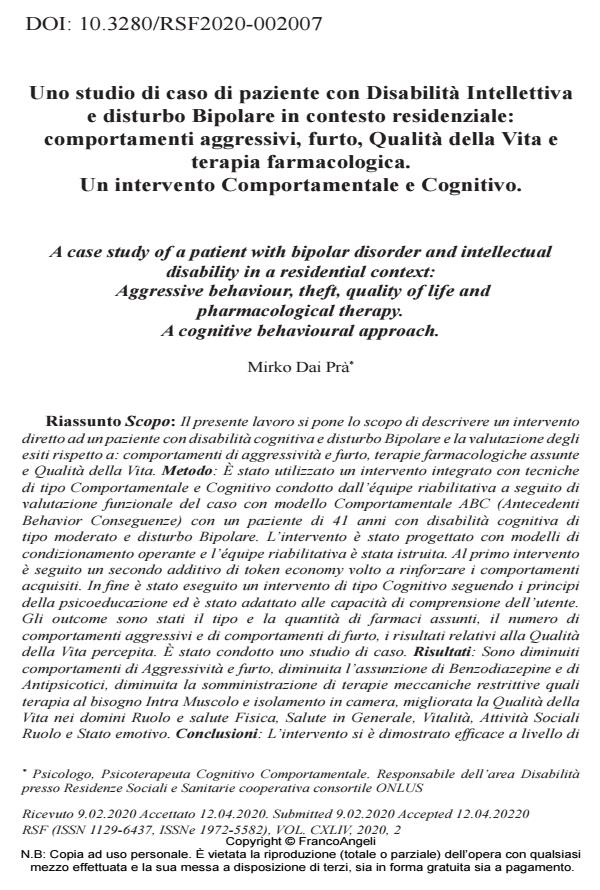A case study of a patient with bipolar disorder and intellectual disability in a residential context: Aggressive behaviour, theft, quality of life and pharmacological therapy. A cognitive behavioural approach.
Journal title RIVISTA SPERIMENTALE DI FRENIATRIA
Author/s Mirko Dai Prà
Publishing Year 2020 Issue 2020/2
Language Italian Pages 26 P. 115-140 File size 302 KB
DOI 10.3280/RSF2020-002007
DOI is like a bar code for intellectual property: to have more infomation
click here
Below, you can see the article first page
If you want to buy this article in PDF format, you can do it, following the instructions to buy download credits

FrancoAngeli is member of Publishers International Linking Association, Inc (PILA), a not-for-profit association which run the CrossRef service enabling links to and from online scholarly content.
The Author presents a case study of a 41 year old patient - with bipolar disorder and cognitive disability - and assesses the outcomes of the intervention examining: aggression, theft, medication and the patient’s perceived quality of life. Methodology: The rehabilitation team, after having completed the functional evaluation of the patient with the ABC Behavioral Model (Antecedent Behavior Consequences), utilized a cognitive behavioral approach to set up an integrated intervention. The team was trained to use operant conditioning. After the first intervention, token economy was introduced to reinforce the newly learnt behavior. Ultimately, a cognitive psycho-educative intervention was added. The contents of the various interventions was adapted to meet the patient's comprehension skills. The outcomes of this study are: type and dosage of medication, the number of aggressive or theft episodes and the patient’s perceived quality of life. Results: Aggressiveness and theft episodes decreased, after having reduced the dosage of the drugs - benzodiazepine, antipsychotic - and having also reduced the restrictive mechanical therapies such as Intra Muscle pro re nata medication and room isolation. The patient’s quality of life - health, vitality, social activities and emotional states - improved. Conclusion: The intervention was effective in decreasing the patient’s problematic behaviour, it helped to reduce medication and increased the patient’s perceived Quality of Life. This case study offers insight on team and individual work with a bipolar and cognitive disabled patient.
Keywords: Aggression, Quality of Life, Bipolar, Disability, Behavioural, Cognitive.
Mirko Dai Prà, Uno studio di caso di paziente con Disabilità Intellettiva e disturbo Bipolare in contesto residenziale: comportamenti aggressivi, furto, Qualità della Vita e terapia farmacologica. Un intervento Comportamentale e Cognitivo. in "RIVISTA SPERIMENTALE DI FRENIATRIA" 2/2020, pp 115-140, DOI: 10.3280/RSF2020-002007